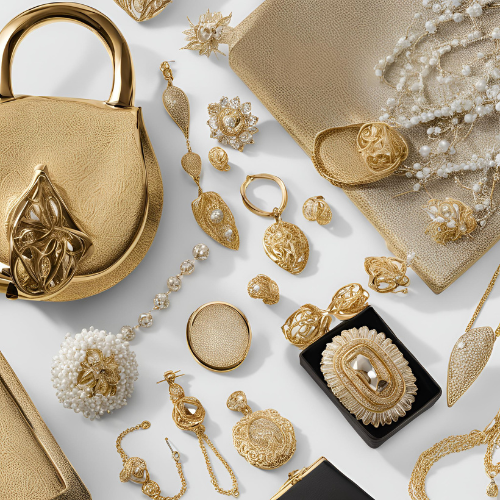The Lustrous Legacy of White Gold Jewelry: A Journey Through Time and Craftsmanship
White gold jewelry, with its sleek, silvery allure, has captivated hearts for over a century. But what exactly is white gold? Is it pure gold? A scientific marvel? A historian’s muse? This article unravels the story of white gold, blending metallurgical science, cultural history, and artistic innovation. We’ll explore its origins, how it’s crafted, and why it became a symbol of modernity. Along the way, you’ll encounter jargon like rhodium plating and ductility, meet scientists who decoded its secrets, and discover how wars and fashion trends shaped its destiny. Let’s dive in!
1. What Is White Gold? The Science Behind the Shine
White gold isn’t a natural metal but a human-made alloy—a blend of pure gold and other "white metals" like nickel, palladium, or silver. Pure gold (24-karat) is too soft for jewelry, so artisans mix it with durable metals to create wearable pieces. The result? A material that’s stronger than yellow gold yet radiates a platinum-like sheen.
Key Jargon Alert:
Alloy: A mixture of metals designed to enhance strength or appearance.
Rhodium Plating: A thin coating of rhodium (a rare, reflective metal) applied to white gold to boost its shine and prevent tarnish.
Fun Fact: The term “white gold” first appeared in patent documents in the early 20th century, but its journey began much earlier.
2. A Historical Deep Dive: The Birth of White Gold
The Platinum Problem (Early 1900s)
In the 1920s, platinum was the darling of jewelry designers. Its strength and cool hue perfectly suited the geometric Art Deco movement. But platinum had two flaws: it was rare and pricey. Enter World War I. By the 1940s, platinum was deemed a “strategic metal” reserved for military use (e.g., aircraft engines), leaving jewelers scrambling for alternatives.
The Invention of White Gold
White gold emerged as the hero. German metallurgists in Pforzheim, a historic jewelry hub, pioneered early alloys by mixing gold with nickel. The result was affordable, durable, and—when rhodium-plated—indistinguishable from platinum. By the 1930s, brands like Cartier and Tiffany & Co. embraced white gold, cementing its status in luxury.
Quote from History:
“The 20th century demanded materials that mirrored its pace—fast, resilient, and adaptable. White gold was that material.” — Dr. Clara Weiss, Historian of Material Culture.
3. Crafting White Gold: From Ore to Adornment
Creating white gold is alchemy meets engineering. Here’s how it’s done:
Alloying: Pure gold is melted with white metals (often 25% nickel or palladium).
Casting: The molten mix is poured into molds to form rings, chains, or settings.
Annealing: Heating and cooling the metal to enhance malleability (ability to be shaped).
Rhodium Plating: A final dip in rhodium solution adds a mirror-like finish.
Why Rhodium? Rhodium doesn’t tarnish, making it ideal for protecting the softer gold beneath. However, this coating wears off over time, requiring re-plating—a process called renewal dipping.
4. White Gold vs. Yellow Gold vs. Platinum: The Ultimate Showdown
Yellow Gold: Classic but soft; prone to scratches.
Platinum: Dense and hypoallergenic but 30x rarer than gold.
White Gold: The “Goldilocks” option—affordable, durable, and versatile.
Cultural Impact: Post-WWII, white gold became a middle-class status symbol. It represented innovation, mirroring the era’s optimism for technology and progress.
5. The Role of Scientists: Decoding the Alloy’s Secrets
While jewelers perfected white gold’s aesthetics, scientists explored its atomic structure. In 1952, metallurgist Dr. Henry Markham published a groundbreaking study on gold-nickel alloys, noting their superior ductility (ability to stretch without breaking).
Quote from Science:
“Alloys are more than mixtures; they’re conversations between elements. White gold whispers the future of metallurgy.” — Dr. Emily Stanton, MIT Materials Scientist (2015).
6. White Gold in Pop Culture: Icons and Trends
1940s Hollywood: Rita Hayworth’s white gold engagement ring sparked a craze.
1980s Hip-Hop: Run-D.M.C. flaunted oversized white gold chains, tying it to urban glamour.
Modern Day: Meghan Markle’s rhodium-plated engagement ring revived interest in vintage designs.
7. Caring for White Gold: Tips from the Pros
Avoid harsh chemicals (bleach erodes rhodium).
Re-plate every 2-3 years to maintain luster.
Store separately to prevent scratches.
Pro Tip: Use a microfiber cloth for polishing—it’s gentle on the patina (surface glow).
8. The Future of White Gold: Sustainability and Innovation
With eco-consciousness rising, labs now recycle gold and use hypoallergenic palladium instead of nickel. Researchers are even testing graphene-infused alloys for unbreakable jewelry!
Conclusion: Why White Gold Endures
White gold is more than a metal—it’s a testament to human ingenuity. From wartime necessity to red-carpet staple, its journey mirrors societal shifts. As Dr. Weiss mused, “Every scratch on a white gold ring tells a story: of eras, experiments, and endless reinvention.”
Whether you’re a history buff, a science geek, or a jewelry lover, white gold offers something timeless. Next time you slip on a rhodium-plated band, remember: you’re wearing a piece of the past, engineered for the future.



